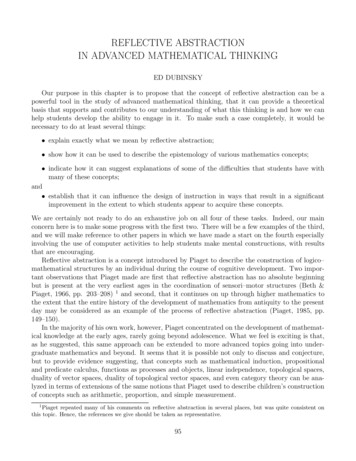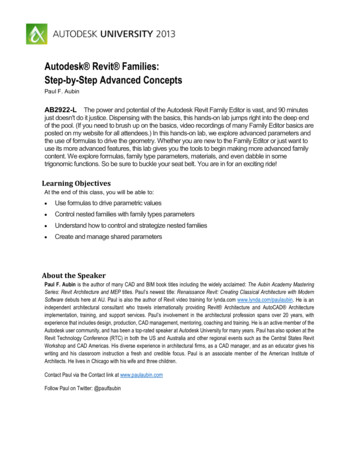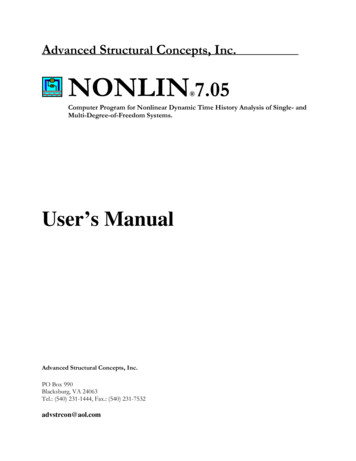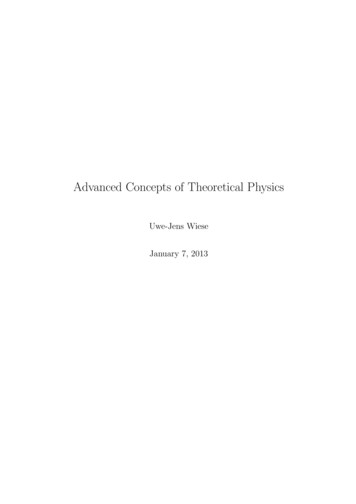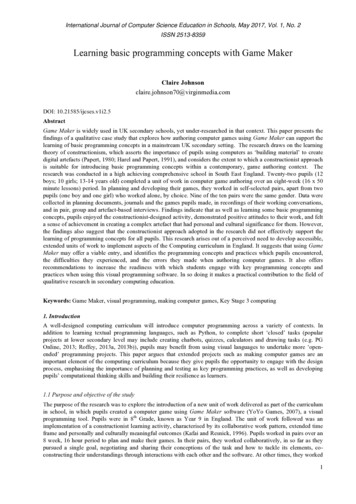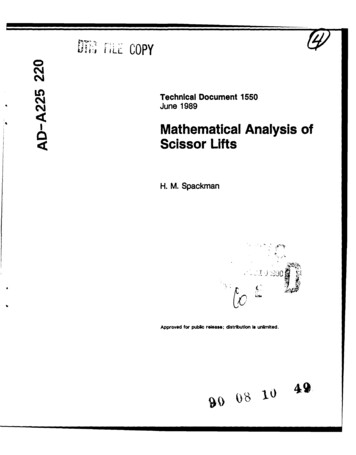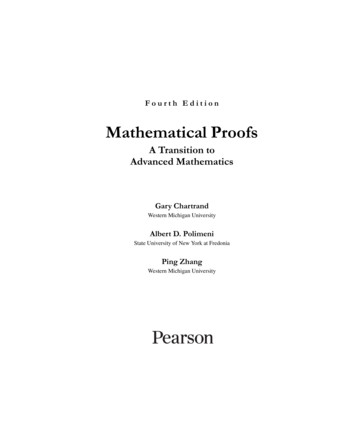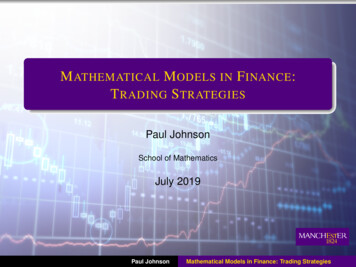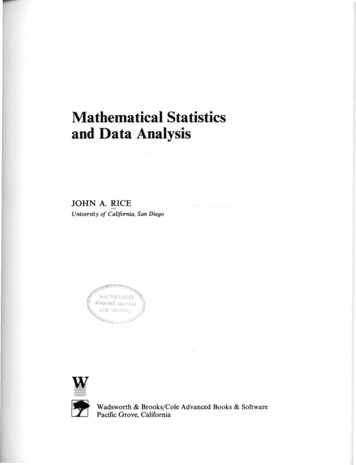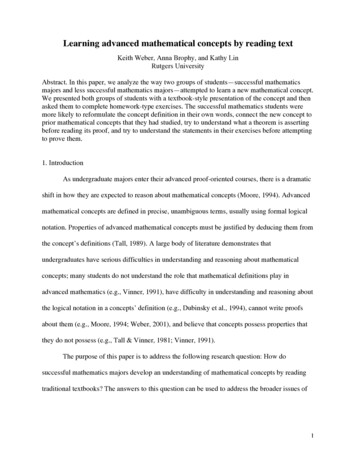
Transcription
Learning advanced mathematical concepts by reading textKeith Weber, Anna Brophy, and Kathy LinRutgers UniversityAbstract. In this paper, we analyze the way two groups of students—successful mathematicsmajors and less successful mathematics majors—attempted to learn a new mathematical concept.We presented both groups of students with a textbook-style presentation of the concept and thenasked them to complete homework-type exercises. The successful mathematics students weremore likely to reformulate the concept definition in their own words, connect the new concept toprior mathematical concepts that they had studied, try to understand what a theorem is assertingbefore reading its proof, and try to understand the statements in their exercises before attemptingto prove them.1. IntroductionAs undergraduate majors enter their advanced proof-oriented courses, there is a dramaticshift in how they are expected to reason about mathematical concepts (Moore, 1994). Advancedmathematical concepts are defined in precise, unambiguous terms, usually using formal logicalnotation. Properties of advanced mathematical concepts must be justified by deducing them fromthe concept’s definitions (Tall, 1989). A large body of literature demonstrates thatundergraduates have serious difficulties in understanding and reasoning about mathematicalconcepts; many students do not understand the role that mathematical definitions play inadvanced mathematics (e.g., Vinner, 1991), have difficulty in understanding and reasoning aboutthe logical notation in a concepts’ definition (e.g., Dubinsky et al., 1994), cannot write proofsabout them (e.g., Moore, 1994; Weber, 2001), and believe that concepts possess properties thatthey do not possess (e.g., Tall & Vinner, 1981; Vinner, 1991).The purpose of this paper is to address the following research question: How dosuccessful mathematics majors develop an understanding of mathematical concepts by readingtraditional textbooks? The answers to this question can be used to address the broader issues of1
how students can successfully develop an understanding of advanced mathematics and whattypes of instructional activities can foster their development.2. Related literature2. 1. Presentation of advanced mathematical concepts in traditional settingsWhen professors introduce new concepts in advanced mathematics courses, theytypically do so using a “definition-theorem-proof” format (Weber, 2004). That is, afterintroducing a concept and its definition, the professor then states theorems about the concept andprovides rigorous proofs to justify these theorems. Davis and Hersh (1981) characterize thispractice by averring that “a typical lecture in advanced mathematics consists of definition,theorem, proof, definition, theorem, proof in solemn and unrelieved concatenation” (p. 151).Raman’s (2004) analysis of textbooks used in advanced mathematical courses reveals thattextbooks introduce concepts in a similar manner. Many mathematics educators andmathematicians are critical of this practice (see Weber, 2004, p. 116-117 for a brief review ofthis literature), in part because understanding a mathematical concept involves more thanknowing its definition and drawing logical deductions from it.2. 2. Learning advanced mathematical conceptsThe issue of how students can learn to understand advanced mathematical concepts is ofobvious importance to collegiate mathematics educators and there has been considerableresearch on this topic. Most of this research has been conducted using design research (Cobb etal., 2003) or a similar methodology. Within this paradigm, researchers engage in an iterativecycle in which they first postulate how students might come to understand a concept and thendesign activities to foster this understanding. They then implement this instruction with a groupof students. An analysis of this implementation is used to refine the theoretical assumptions ofhow students can learn and the instructional activities. In Asiala et al. (1996), leading2
researchers in collegiate mathematics education advocate for this type of research. Researchwithin this framework has produced effective instruction for advanced mathematical courses(e.g., Dubinsky et al., 1994; Asiala et al., 1996; Larsen, 2004).2. 3. How students learn advanced mathematical concepts in traditional settingsResearch on how students learn advanced mathematical concepts under traditionalinstruction is sparse. Dahlberg and Housman (1997) observe that generating examples ofadvanced mathematical concepts creates learning opportunities for students, but examplegeneration is not a process that most students engage in during traditional instruction (e.g.,Moore, 1994). Several other studies observe how students learn advanced mathematical conceptsover the course of a semester (e.g., Pinto & Tall, 1999; Alcock & Simpson, 2004). Howeverthese studies focus on stages that students progress through as they come to understand a conceptbut do not focus on how students develop this understanding.Traditional instruction of advanced mathematics is widely criticized and is generallyregarded as unsuccessful. Nonetheless, some students are able to learn in traditional classrooms.Understanding how these students learn can be useful for two reasons. First, this may suggestpossible learning trajectories that might be useful for less successful students. Second, while thedesign-based research described in the previous section has produced effective instruction, thisinstruction has not enjoyed widespread application, in part because its implementation requiresmathematics professors to radically alter their approach to teaching. Understanding the strategiesthat successful students use in traditional settings may lead to instructional recommendations thatdo not require professors to completely overhaul their instruction.2. 4. Learning by reading textIn advanced mathematics courses, students are expected to learn in large part by studyingdefinitions (Dahlberg & Housman, 1997) and reading proofs (Selden & Selden, 1995). There is a3
large body of work on reading comprehension that delineates the cognitive processes anddescribes the cognitive strategies used by readers to comprehend text. Palinscar and Brown(1984) describe metacognitive strategies that are used by good readers. When reading, goodreaders will engage in strategies such as summarizing the paragraph that they just read, relatingwhat they read to their prior knowledge, and predicting the direction in which they think theargument is heading. These strategies serve two purposes. The first is to foster comprehension byallowing the reader to construct an interpretation of the text that is meaningful to them. Thesecond is to monitor comprehension; if the reader is unable to execute a metacognitive strategy(e.g., if they are unable to summarize a paragraph or an argument takes a turn that they did notexpect), this serves as a cue to the reader that comprehension is not proceeding smoothly andremedial action, such as re-reading the text or seeking clarification, is necessary.Chi and her colleagues argue that generating self-explanations is necessary for students tounderstand scientific texts (Chi et al., 1989, 1994). Because scientific texts would be impossiblylong if every detail of the argument was spelled out, even quality expositions require the readerto fill in substantial details. Successful students will routinely generate explanations for how newsentences in the text they read connect to previous sentences and their own informalunderstandings. Chi et al. (1994) conjecture that generating self-explanations facilitates learningbecause this generation requires readers to constructively interpret the text that they are reading,connect what they are reading to their prior knowledge, and at times compel them to resolveinconsistencies between what is being asserted in the text and what they believe to be true.While there is little literature on how students learn mathematics by reading text, webelieve that good students may use analogous strategies. Because understanding a conceptinvolves more than being able to state its definition (Vinner, 1991), students must engage inactivities that allow them to build personally meaningful images of the concept that are aligned4
with the concept definition. Because proofs would be intractable if every logical detail wasspelled out (e.g., Davis & Hersh, 1981), details of how new assertions follow from previous onesare often left to the reader sometimes requiring the reader to invoke his or her prior knowledge(Weber & Alcock, 2005). A central purpose of this study is to understand the strategies thatsuccessful students use to learn advanced mathematical concepts from traditional text.3. Methods3. 1. MaterialsThis study examines how students came to understand the concept of functionpreservation, which has the following definition: Let f be a real–valued function and A be asubset of the real numbers. f is defined to be preserved on A if f(A) is a subset of A.The first author generated this concept, believing it would be appropriate for this studyfor the following reasons. First, this definition is based on basic concepts from set theory thatwere covered in the students’ transition-to-proof course. Thus, the participants, who had allsuccessfully completed a transition-to-proof course, should possess the background knowledgeto comprehend the definition. Second, the concept of function preservation is not directlyanalogous to other concepts in advanced mathematics so all participants would be learning thisconcept for the first time. Third, despite its relative simplicity, this concept was rich enough thatit could be represented in a variety of ways (symbolically, by prototypical examples, graphically,diagrammatically) and interesting theorems could be proven about it.The first author created a written presentation of this concept that we believe isrepresentative of how textbooks in undergraduate mathematics courses introduce new concepts.In pilot studies, mathematicians and undergraduate students agreed that this prose wasrepresentative of a textbook presentation. The written presentation consisted of four parts, eachon a separate sheet of paper: (a) the definition of the concept, (b) two examples and one non5
example of the concept, (c) three theorems and proofs about the concept, and (d) nine exercisesabout the concept. This presentation can be found in the Appendix of this paper.3. 2. ParticipantsTwo groups of students participated in this study: Eight undergraduate mathematics majors who completed a course in real analysis andearned greater than a 3.4 GPA in their proof-oriented mathematics courses. Thesestudents are referred to as the successful mathematics majors, or SMMs. Eight undergraduate mathematics majors who completed a course in real analysis andearned lower than a 3.0 GPA in their proof-oriented mathematics courses. Their analysisteachers indicated that these students put forth adequate effort in their real analysis coursebut still struggled. These students are referred to as the less successful mathematicsmajors, or LSMMs.3. 3. ProcedureParticipants each met individually with the first author for a task-based interview that wasaudio-taped. Participants were asked to “think aloud” while they attempted to understand a newmathematical concept. At the start of the interview, they were given the definition of functionpreservation that they were allowed to read until they felt they understood it. They were thengiven a sheet of paper with examples of the concept. When they indicated that they understoodthe prose on this sheet, they were given a sheet of paper with theorems and proofs. Next,participants were asked to complete the nine exercises in any way they saw fit. (Participants’written work was collected as data.) Finally, participants were asked a series of open-endedquestions about their mathematical study habits in general (e.g., “Describe for me some of thethings that you do when you encounter a new mathematical concept?”) and about interesting6
behavior they exhibited during the interview. Participants were given as long as they liked tocomplete each stage of the interview; most interviews lasted about one hour.3. 4. AnalysisAll audiotapes were transcribed and the data were analyzed using Chi’s (1997) methodfor coding verbal data. In a first pass through the data, an inductive coding scheme was generatedto describe the strategies that participants used to understand the function preservation concept.After this coding scheme was operationalized, two coders independently coded all the data. Thiscoding allows us to count occurrences of strategy usage and present our qualitative findings in aquantitative form.4. Results4. 1. Reading the definitionThe strategies used by both groups of participants are presented in Table 1.TABLE 1. Reading the definitionSMMsReformulate definition8Relate definition to another concept5Draw a diagram3Recall related definitions1LSSMs5002Reformulating the definition—When reading the definition of the concept, the majority of theparticipants attempted to provide an alternative formulation of the concept. Three examples ofreformulation are provided below:SMM6: Okay, I guess that means that if the operation that f performs on the elements of A isclosed over A. I think I understand that.SMM5: Preserved. f maps a subset on itself. Okay. I understand that.LSMM2: So, does this just mean that the output of everything that is in A is also in A? Yeah,okay, the output of f is in the set A. Okay.In most instances of reformulation, the participants expressed the ideas of the definition ininformal mathematical language, but this was not always the case. For example, SMM4 provided7
a logically equivalent definition to the one provided, noting that f was preserved on A if frestricted to A was a function from A to A. All of the SMMs reformulated the concept, but threeof the LSMMs did not.Relating function preservation to other mathematical concepts. When reading the definition offunction preservation, five SMMs compared function preservation to other concepts that theyhad learned, such as linear transformations and scalar multiplication in vector spaces and closedgroup operations. No LSMM attempted to compare function preservation with anothermathematical concept.Other observations. Three other observations are worth noting. First, no participant generated anexample of a function preserved over a particular set when they read the concept definition. Thisdiffers from Dahlberg and Housman’s (1997) finding that some strong students willspontaneously generate examples of new concepts but is consistent with Moore’s (1994) claimthat undergraduates are frequently unwilling or unable to generate examples of concepts withoutprompting. Second, there were three instances in which the SMMs considered a diagram of whatit would mean for a function to be preserved on a set. No LSMM considered a diagram. Third,the participants spent relatively little time studying the definition of the concept. Thirteen of the16 participants spent under two minutes studying the concept; the other three participants (oneSMM, two LSMMs) spent longer primarily because they had difficulty recalling what it meant toevaluate a function over a set.Summary. Overall, the SMMs processed the definition of function preservation more extensivelythan the LSMMs. The SMMs were more likely to reformulate the definition, connect functionpreservation to other mathematical concepts, and draw or imagine a diagram illustrating theconcept. Dahlberg and Housman (1997) argue that reformulating concept definitions allowsstudents to build an image of the concept definition, something they believe is necessary for8
students to use the definition in problem solving and proof writing. Drawing analogies betweenfunction preservation and other concepts enables students to build links between what they arelearning and what they already know, a constructive process that Chi et al. (1994) argued isessential for understanding scientific text. As Hiebert and Lefevre (1986) argued that conceptualunderstanding consists of the links one has between mathematical concepts, comparing newconcepts to old ones may be directly beneficial to students.4. 2. Reading examples, theorems, and proofsThe strategies that both groups of students used to read the examples, theorems, andproofs are presented in Table 2.TABLE 2. Reading examples and proofsSMMsLSMMsReading the claim to be provenReformulate the claim5(8)2(2)Recall relevant definitions3(3)1(1)Evaluate/prove statement priorto reading the proof6(11)3(5)Re-read the statement5(9)4(5)Ask for clarification4(6)0(0)Reading the proof of the claimRephrase part of the argument5(9)6(12)Justify a step within a proof4(7)7(17)Anticipate arguments while3(4)0(0)reading the proofRe-read the proof3(3)0(0)The table lists number of distinct participants, with the number of instances in parentheses.4. 2. 1. Reading the statement prior to reading the proofReformulating the statement. There were eight instances in which the SMMs reformulated thestatement that was being proved prior to reading its proof. In the excerpt below, SMM5reformulated Theorem 2. Like many participants, SMM5 had initial difficulty understandingwhat Theorem 2 was asserting, but resolved this difficulty by reformulating the statement in away that made sense to him.9
SMM5: [reading the theorem] r is real and there is a set that’s not real and r is in that set.OK, that much I don’t get [ ] Oh, OK, it’s not the whole number line, all the realnumbers. So r is in this set and f is closed on this set, a non-trivial subset of the realnumbers containing the number.Evaluating the veracity of the statement. SMMs were twice as likely as LSMMs to considerwhether the statement was true prior to reading its proof. In some cases, the participantsattempted to make this judgment by constructing a justification or proof in support of thestatement; in others, they provided an intuitive argument or no argument at all (e.g., saying, “thatseems true” or “that makes sense”). Two instances of participants evaluating a statement’sveracity are provided below:SMM8: [Reading Theorem 1] Then f is preserved on A union B. OK. Makes sense. If x isin either A or B, then f(x) should be in either. Let’s see proof.LSMM5: [For Example 1] [Student writes: -1 x 1 // 1 x2 1// x2 1 // x2 is in [0, 1]]Clearly LSMM5’s reasoning for why f(x) x2 is preserved on [0, 1] was invalid, but as this studyfocuses on strategies students employ, rather than their success in employing them, this was stillcoded as evaluating the statement.Re-reading the statement. SMMs were more likely to re-read the statement. In general, they didso when they were unable to comprehend what they just read, as is illustrated in the two excerptson Theorem 2 below:SMM6: “Theorem two, let r be a real number. Then there is a set C sub r which is not inthe real numbers, so it's a complex number, right? Such that r is a complex number.What? Wait, wait, wait. Okay. r is a real number.”SMM2: “There is a non-trivial subset of the real numbers containing that number that f ispreserved on. Okay, what does that mean? Let R be a real number, Cr not equal to Rsuch that R is an element of Cr.”In the first excerpt SMM6 is rephrasing Theorem 2 in his own words as he is reading it.Upon reading Cr R, he erroneously infers that Cr must consist of complex numbers. Fromthere, he infers r must be complex after reading r is an element of Cr. To SMM6, this contradictsthe earlier claim that r is real. Upon recognizing this contradiction, he returns to the beginning of10
the statement to read it again. Similarly, when SMM2 is unable to understand an informalsummary of Theorem 2, he re-reads the statement from the beginning.Request for clarification. There were six instances when SMMs asked the interviewer forclarification on some aspect of the statement to be proven. Generally, this consisted of attemptsto understand notations or conventions in the proof. No LSMM did this. As it seems reasonableto expect that SMMs would be at least as familiar with mathematical notation and convention asLSMMs, this implies LSMMs were more likely to accept a notation they did not understandwithout asking for assistance.Summary. Selden and Selden (1995) observe that students often have difficulty understandingwhat mathematical propositions are actually asserting and consequently will not find proofs ofthese propositions to be convincing. In general, the SMMs spent more time trying to understandwhat was being asserted than the LSMMs. The SMMs’ strategies for developing thisunderstanding where analogous to Palinscar and Brown’s (1984) comprehension-fostering andcomprehension-monitoring metacognitive strategies. The SMMs tried to foster comprehensionby understanding what the proposition was asserting (by describing it in their own words) andseeing if it made sense (by evaluating the statement’s veracity). When they were unable to do so,they would take remedial actions such as re-reading the text or asking for clarification.4. 2. 2. Reading the proofsSummary. Perhaps surprisingly, the LSMMs were more likely to rephrase aspects of the proofs intheir own words and justify particular steps within a proof. There are (at least) two hypothesesthat can account for this observation. First, perhaps more of the statements were obvious to theSMMs than to the LSMMs, so the SMMs felt less need to justify these statements. (In a studyconducted with mathematicians reading proofs, they offered no justification for the largemajority of assertions within a proof that they read (Weber, 2008)). Second, it is possible that11
focusing on the line-to-line logic within a proof is less important for mathematical learning thanthe first author has previously asserted elsewhere (e.g., Weber & Alcock, 2005; Weber et al.,2008). It may be the case that stronger students focus on the larger ideas in the proof and spendless time verifying the mundane details within a proof. More research is needed to determinewhich hypothesis (if either) is correct.4. 3. Completing the exerciseNot surprisingly, the SMMs collectively outperformed the LSMMs on the exercises,getting a greater percentage correct (82.3% vs. 53.4%), despite trying more of the advancedexercises. The strategies each group used to complete the exercises are presented in Table 3.TABLE 3. Completing the exercisesSMMsLSMMsReading the problem statementReformulate the statement6(15)1(1)Evaluate truth or falsity of statement8(26)5(6)prior to proof writingRe-read the exercise4(8)3(5)Recall definitions7(14)7(12)Referring to text while completing the exerciseRefer to text at all5(10)Use text as a template for a proof0(0)Use text to find useful results3(3)Use text to see how new argument2(2)should be written8(33)7(14)3(3)3(4)Strategies used while writing proofsGive justification or informal argument7(12)3(5)prior to writing proofConsider truth or falsity of statement6(12)2(4)after proof has begunConstruct a diagram6(8)0(0)Consider an example3(3)3(4)Evaluate proof for correctness2(6)2(3)The table lists the number of distinct participants, with the number of instances in parentheses.4. 3. 1. Prior to attempting to write a proof12
Reformulating the statement. SMMs frequently would reformulate a statement prior to writing aproof. Two examples of this are provided below:SMM3: [For number 6] f of Z is preserved on Z and g of Z is preserved on Z and we wantthat f plus g is preserved on Z. So.wait a minute.f and g are real-valued functions.So, maybe we’re saying that if you take an integer and you apply function f or g to thatinteger, then you get an integer. So then, this is basically just saying that the sum of twointegers is an integer.SMM5: [on number 8] We’ve got a subset [referring to E]. So by subset you might meanthat it could probably mean D as well .So we’re looking for.there exists a set Dand f is preserved on E. And E contains the real numbers. E could be a lot of differentthings. We don’t know if f is preserved on D question we could show the epsilondelta crap and proofs of 311 [advanced calculus].These two episodes illustrate the benefits of reformulation. In the first episode, SMM3’sreformulation of exercise 6 essentially is an informal version of the proof he then produced. Inthe second episode, SMM5’s reformulation of exercise 8 enabled her to recognize it as a “for allthere exists” statement, which suggested an appropriate proof framework (Selden & Selden,1995).Evaluating the veracity of the statement. There were 26 instances in which the SMMs evaluatedthe veracity of the statement prior to constructing a proof, as compared with only 6 from theLSMMs. That the SMMs made these evaluations so often was not surprising—there were fiveexercises in which students were asked to “prove or disprove” so determining whether astatement was true or false was necessary to decide how to proceed. In contrast, LSMMsfrequently assumed the “prove or disprove” statements were true and attempted to prove them.Summary. Selden and Selden (1995) observe that students frequently have difficulty determiningwhat is being asserted in a mathematical statement. Consequently, these students often havetrouble proving statements, since they cannot determine what to assume and what to conclude.The SMMs’ reformulation of the statements and determination of whether to produce a proof orcounterexample allowed them to understand what they needed to prove, which helped them intheir proof construction. Schoenfeld (1985) observed that good problem solvers spent more time13
understanding their task than weak problem solvers, who tended to dive right into calculations.This finding is also present in our data; SMMs spent more time determining what they needed toprove, whereas LSMMs spent less time processing the statement to be proven.4. 3. 2. Constructing the proofsReferring to text. When doing the exercises, participants were permitted to refer to the writtentext they had previously read. Both SMMs and LSMMs did so, although LSMMs did so threetimes as often and earlier in their proof attempts. The SMMs and LSMMs used the text indifferent ways. The SMMs used the text primarily to look up definitions or see how a proof theywere writing should be structured. The LSMMs would often use the text to write template-basedproofs (cf., Weber, 2005), locating a proof of a theorem similar to the statement they wereproving, and producing a nearly identical proof by changing variables within the proof. Forinstance, LSMM5 wrote the following proof for Exercise 2:Let f (x) x/2. Show that f is not preserved on Z.Counterexample. A [0,2]Let x Œ A, picking x 1f (1) 1/2 À [0,2].So f ([0,2]) À [0,2].By itself, this argument looks bizarre. However LSSM5’s work makes sense given that she based†her proof directly on the proof given for Example 3. (Both Exercise 2 and Example 3 requiredproofs showing a particular function was not preserved over a given set). For Exercise 4, whichasks students to prove or disprove that if a function f was preserved on A and B, then it waspreserved on A « B, LSMM6 wrote a proof nearly identical to that of Theorem 1, simplyreplacing every union with an intersection. Hence, her proof had invalid inferences, such as“since f(x) is a member of A, f(x) is a member of A « B”. In her post-interview, I asked LSSM6about this statement:14
LSSM6: [surprised] Oh Wow! That’s not true at all.K: Would you be able to say it [ ] Would you be able to see a way to ?LSSM6: Yeah, yeah. Because we know x is in A and x is in B, which means that f of x is in Aand f of x is in B since f is preserved on A and B. So then f of x is in the intersection of Aand B.This excerpts illustrates two important points. First, LSMMs relying on template-based proofswould write assertions that, at least with reflection, they knew were not true. (Similarly, it seemsunlikely that LSMM5 believed that 1/2 was not in the interval [0, 2] as she wrote in the invalidproof presented above). In other words, the LSMMs sometimes suspended sense-making in theirtemplate-based proofs. Second, in some cases, the LSMMs could have produced a valid proofhad they chosen to rely on their own mathematical resources, instead of relying on templates.Other observations. The SMMs were more likely than the LSMMs to give an intuitivejustification for why an assertion was true prior to writing a formal proof (SMM3’sreformulation of Exercise 6 presented earlier in the text is an example of this). SMMs also weremore likely to reconsider the veracity of the statement they were proving during their proofattempt. Although the SMMs sometimes produced diagrams (usually Venn diagrams) and theLSMMs did not, these diagrams were generally not helpful and sometimes misleading. Forinstance, several SMMs used diagrams to convince themselves that Exercise 4 was false, when infact it was true.Summary. Elsewhere we argue that what an individual has the opportunity to learn byconstructing a proof depends on what that individual focuses on during the construction (Weber,2005). LSMMs often relied on template-based proofs, which is consistent with the finding thatless successful students are likely to abandon sense-making when using worked examples tosolve new problems (e.g., VanLehn, Jones, & Chi, 1991). While this may provide the LSMMspractice with learning procedures that can prove a class of mathematical statements, producingtemplate-based proofs will likely not provide LSMMs with the opportunity to refine their15
understanding of the concepts they are studying or obtain conviction or understanding in theassertions they are proving. The SMMs sometimes produced an intuitive argument for whyassertions should be true before providing formal justifications, while the LSMMs rarely did th
As undergraduate majors enter their advanced proof-oriented courses, there is a dramatic shift in how they are expected to reason about mathematical concepts (Moore, 1994). Advanced mathematica
